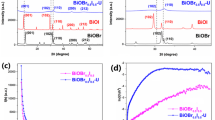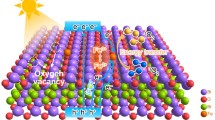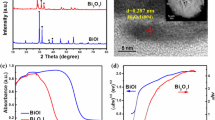Abstract
Plasmonic bismuth (Bi0) nanoparticle-decorated flower-like CeO2−δ (Bi0/CeO2−δ) photocatalysts with abundant oxygen vacancies (OVs) were synthesized via a solvothermal method. The OVs can not only improve the separation of electron-hole pairs, but also facilitate the adsorption and activation of gas molecules (NO/O2). In addition, the Bi0 nanoparticles can enhance the visible light response and prevent the recombination of charge carriers by virtue of the surface plasmon resonance (SPR) effect, achieving an excellent ability for NO elimination and NO2 inhibition under visible light irradiation. Density functional theory (DFT) calculations confirm that the Schottky barrier between Bi0 and CeO2−δ accompanied with the OVs are pivotal for the migration of photogenerated charge carriers to involve in the photocatalytic NO removal. Trapping experiments and in situ FTIR spectroscopy were conducted to explore the mechanism of the photocatalytic NO removal, suggesting that the photocatalytic NO removal can be significantly enhanced by introducing abundant OVs and the involvement of Bi0 metal nanoparticles.

摘要
本文利用溶剂热法合成了Bi0纳米颗粒修饰的富氧空位 (OVs)花型CeO2−δ (Bi0/CeO2−δ)光催化剂. OVs不仅能够加速电子-空穴对的分离, 而且有利于气体分子(NO/O2)的吸附和活化. 此外, Bi0纳米颗粒具有表面等离子体共振效应, 它能够提高催化剂的可 见光响应、减少光生载流子的复合. Bi0/CeO2−δ光催化剂在可见光 下具有优异的一氧化氮(NO)去除活性, 并可有效抑制NO2生成. 密 度泛函理论(DFT)计算证实, Bi0与CeO2−δ界面处的肖特基势垒以及 OVs的存在促进了载流子的分离, 进而参与NO的光催化去除. 通过 捕获实验和原位红外光谱分析了Bi0/CeO2−δ催化剂光催化去除NO 的机理, 研究表明丰富的OVs和金属纳米颗粒负载能够显著提高材 料光催化去除NO的性能.
Similar content being viewed by others
References
Dong F, Zhao Z, Sun Y, et al. An advanced semimetal-organic Bi spheres-g-C3N4 nanohybrid with SPR-enhanced visible-light photocatalytic performance for NO purification. Environ Sci Technol, 2015, 49: 12432–12440
Bui PD, Tran HH, Kang F, et al. Insight into the photocatalytic mechanism of tin dioxide/polyaniline nanocomposites for NO degradation under solar light. ACS Appl Nano Mater, 2018, 1: 5786–5794
Signoretto M, Ghedini E, Trevisan V, et al. TiO2-MCM-41 for the photocatalytic abatement of NOx in gas phase. Appl Catal B-Environ, 2010, 95: 130–136
Xiao F, Zhou W, Sun B, et al. Engineering oxygen vacancy on rutile TiO2 for efficient electron-hole separation and high solardriven photocatalytic hydrogen evolution. Sci China Mater, 2018, 61: 822–830
Zhang J, Zhu G, Li S, et al. Novel Au/La-Bi5O7I microspheres with efficient visible-light photocatalytic activity for NO removal: synergistic effect of Au nanoparticles, La doping, and oxygen vacancy. ACS Appl Mater Interfaces, 2019, 11: 37822–37832
Guo Y, Chang B, Wen T, et al. A Z-scheme photocatalyst for enhanced photocatalytic H2 evolution, constructed by growth of 2D plasmonic MoO3−x nanoplates onto 2D g-C3N4 nanosheets. J Colloid Interface Sci, 2020, 567: 213–223
Channei D, Nakaruk A, Phanichphant S. Influence of graphene oxide on photocatalytic enhancement of cerium dioxide. Mater Lett, 2017, 209: 43–47
Wang J, Li Z, Zhang S, et al. Enhanced NH3 gas-sensing performance of silica modified CeO2 nanostructure based sensors. Sens Actuat B-Chem, 2018, 255: 862–870
Al-Hetlani E, Amin MO, Madkour M, et al. CeO2-CB nanocomposite as a novel SALDI substrate for enhancing the detection sensitivity of pharmaceutical drug molecules in beverage samples. Talanta, 2018, 185: 439–445
Wang Z, Jiang S, Li Y, et al. Highly active CeO2 hollow-shell spheres with Al doping. Sci China Mater, 2017, 60: 646–653
Li X, Zhang W, Cui W, et al. Reactant activation and photocatalysis mechanisms on Bi-metal@Bi2GeO5 with oxygen vacancies: A combined experimental and theoretical investigation. Chem Eng J, 2019, 370: 1366–1375
Ran M, Wang H, Cui W, et al. Light-induced generation and regeneration of oxygen vacancies in BiSbO4 for sustainable visible light photocatalysis. ACS Appl Mater Interfaces, 2019, 11: 47984–47991
Zhao Z, Cao Y, Dong F, et al. The activation of oxygen through oxygen vacancies in BiOCl/PPy to inhibit toxic intermediates and enhance the activity of photocatalytic nitric oxide removal. Nanoscale, 2019, 11: 6360–6367
Wen XJ, Niu CG, Huang DW, et al. Study of the photocatalytic degradation pathway of norfloxacin and mineralization activity using a novel ternary Ag/AgCl-CeO2 photocatalyst. J Catal, 2017, 355: 73–86
Mittal M, Gupta A, Pandey OP. Role of oxygen vacancies in Ag/Au doped CeO2 nanoparticles for fast photocatalysis. Sol Energy, 2018, 165: 206–216
Chen M, Li Y, Wang Z, et al. Controllable synthesis of core-shell Bi@amorphous Bi2O3 nanospheres with tunable optical and photocatalytic activity for NO removal. Ind Eng Chem Res, 2017, 56: 10251–10258
Li X, Zhang W, Li J, et al. Transformation pathway and toxic intermediates inhibition of photocatalytic NO removal on designed Bi metal@defective Bi2O2SiO3. Appl Catal B-Environ, 2019, 241: 187–195
Huang Y, Liu J, Cao D, et al. Separation of hot electrons and holes in Au/LaFeO3 to boost the photocatalytic activities both for water reduction and oxidation. Int J Hydrogen Energy, 2019, 44: 13242–13252
Hu H, Qian D, Lin P, et al. Oxygen vacancies mediated in-situ growth of noble-metal (Ag, Au, Pt) nanoparticles on 3D TiO2 hierarchical spheres for efficient photocatalytic hydrogen evolution from water splitting. Int J Hydrogen Energy, 2020, 45: 629–639
Huang Z, Zhang Y, Dai H, et al. Highly dispersed Pd nanoparticles hybridizing with 3D hollow-sphere g-C3N4 to construct 0D/3D composites for efficient photocatalytic hydrogen evolution. J Catal, 2019, 378: 331–340
Zhang W, Wang B, Hao C, et al. Au/Cu2O Schottky contact heterostructures with enhanced photocatalytic activity in dye decomposition and photoelectrochemical water splitting under visible light irradiation. J Alloys Compd, 2016, 684: 445–452
Wang M, Zhang Y, Jin C, et al. Fabrication of novel ternary heterojunctions of Pd/g-C3N4/Bi2MoO6 hollow microspheres for enhanced visible-light photocatalytic performance toward organic pollutant degradation. Separ Purific Tech, 2019, 211: 1–9
Xia Y, Cheng B, Fan J, et al. Near-infrared absorbing 2D/3D ZnIn2S4/N-doped graphene photocatalyst for highly efficient CO2 capture and photocatalytic reduction. Sci China Mater, 2020, 63: 552–565
Ding H, Yang J, Ma S, et al. Large dimensional CeO2 nanoflakes by microwave-assisted synthesis: lamellar nano-channels and surface oxygen vacancies promote catalytic activity. ChemCatChem, 2018, 10: 4100–4108
Yang Y, Xing L, Ren W, et al. Oxygen activation through β-Bi2O3 and ultrafine CeO2 interactions to promote catalytic soot combustion. Ind Eng Chem Res, 2019, 58: 22006–22014
Hu J, Chen D, Li N, et al. Fabrication of graphitic-C3N4 quantum dots/graphene-InVO4 aerogel hybrids with enhanced photocatalytic NO removal under visible-light irradiation. Appl Catal B-Environ, 2018, 236: 45–52
Behera A, Kandi D, Martha S, et al. Constructive interfacial charge carrier separation of a p-CaFe2O4@n-ZnFe2O4 heterojunction architect photocatalyst toward photodegradation of antibiotics. Inorg Chem, 2019, 58: 16592–16608
Zhao Z, Zhang W, Sun Y, et al. Bi cocatalyst/Bi2MoO6 microspheres nanohybrid with SPR-promoted visible-light photocatalysis. J Phys Chem C, 2016, 120: 11889–11898
Zhu G, Hojamberdiev M, Zhang S, et al. Enhancing visible-light-induced photocatalytic activity of BiOI microspheres for NO removal by synchronous coupling with Bi metal and graphene. Appl Surf Sci, 2019, 467–468: 968–978
Underwood GM, Miller TM, Grassian VH. Transmission FT-IR and Knudsen cell study of the heterogeneous reactivity of gaseous nitrogen dioxide on mineral oxide particles. J Phys Chem A, 1999, 103: 6184–6190
Rao F, Zhu G, Hojamberdiev M, et al. Uniform Zn2+-doped BiOI microspheres assembled by ultrathin nanosheets with tunable oxygen vacancies for super-stable removal of NO. J Phys Chem C, 2019, 123: 16268–16280
Hadjiivanov K, Avreyska V, Klissurski D, et al. Surface species formed after NO adsorption and NO + O2 coadsorption on ZrO2 and sulfated ZrO2: An FTIR spectroscopic study. Langmuir, 2002, 18: 1619–1625
Hu H, Cai S, Li H, et al. In situ DRIFTs investigation of the low-temperature reaction mechanism over Mn-doped Co3O4 for the selective catalytic reduction of NOx with NH3. J Phys Chem C, 2015, 119: 22924–22933
Martirosyan GG, Azizyan AS, Kurtikyan TS, et al. In situ FT-IR and UV-vis spectroscopy of the low-temperature NO disproportionation mediated by solid state manganese(II) porphyrinates. Inorg Chem, 2006, 45: 4079–4087
Wu J, Cheng Y. In situ FTIR study of photocatalytic NO reaction on photocatalysts under UV irradiation. J Catal, 2006, 237: 393–404
Hadjiivanov K, Knözinger H. Species formed after NO adsorption and NO + O2 co-adsorption on TiO2: an FTIR spectroscopic study. Phys Chem Chem Phys, 2000, 2: 2803–2806
Feng X, Zhang W, Sun Y, et al. Fe(III) cluster-grafted (BiO)2CO3 superstructures: in situ DRIFTS investigation on IFCT-enhanced visible light photocatalytic NO oxidation. Environ Sci-Nano, 2017, 4: 604–612
Wang H, Sun Y, Jiang G, et al. Unraveling the mechanisms of visible light photocatalytic NO purification on earth-abundant insulator-based core-shell heterojunctions. Environ Sci Technol, 2018, 52: 1479–1487
Huang SJ, Walters AB, Vannice MA. Adsorption and decomposition of NO on lanthanum oxide. J Catal, 2000, 192: 29–47
Shang H, Li M, Li H, et al. Oxygen vacancies promoted the selective photocatalytic removal of NO with blue TiO2via simultaneous molecular oxygen activation and photogenerated hole annihilation. Environ Sci Technol, 2019, 53: 6444–6453
Li H, Wu T, Cai B, et al. Efficiently photocatalytic reduction of carcinogenic contaminant Cr (VI) upon robust AgCl:Ag hollow nanocrystals. Appl Catal B-Environ, 2015, 164: 344–351
Cui YL, Guo XN, Wang YY, et al. Visible-light-driven photocatalytic N-arylation of imidazole derivatives and arylboronic acids on Cu/graphene catalyst. Sci Rep, 2015, 5: 12005–12013
Chang L, Zhu G, Hassan QU, et al. Synergetic effects of Pd0 metal nanoparticles and Pd2+ ions on enhanced photocatalytic activity of ZnWO4 nanorods for nitric oxide removal. Langmuir, 2019, 35: 11265–11274
Lei B, Cui W, Sheng J, et al. Synergistic effects of crystal structure and oxygen vacancy on Bi2O3 polymorphs: intermediates activation, photocatalytic reaction efficiency, and conversion pathway. Sci Bull, 2020, 65: 467–476
Acknowledgements
This work was supported by the National Natural Science Foundation of China (51772183, 21673118 and 21972067), the Key Research and Development Program of Shaanxi Province (2018ZDCXL-SF-02-04), the Natural Science Foundation of Hubei Province (2019CFB225), and the Fundamental Research Funds for the Central Universities (GK201903023 and GK201801005).
Author information
Authors and Affiliations
Contributions
Zhu G and Shen Q designed the project; Nie J and Rao F performed the experiments; Nie J, Zhang W and Rao F performed the data analysis; Zhu G, Zhang W and Gao J contributed to the theoretical analysis; Nie J, Zhu G, Shen Q and Hojamberdiev M wrote the paper. All authors contributed to the general discussion.
Corresponding authors
Additional information
Conflict of interest
The authors declare no competing financial interest.
Junli Nie is now pursuing her Master degree in the School of Physics and Information Technology, Shaanxi Normal University. Her current research interest mainly lies in the preparation of photocatalytic materials and their photocatalytic activity for NO removal.
Gangqiang Zhu is now a professor in the School of Physics and Information Technology, Shaanxi Normal University. He received his PhD from Xi’an Jiaotong University (XJTU) in 2012. His research interests mainly focus on the high-performance photocatalytic materials and their photocatalytic mechanisms for environmental purification. He has published more than 100 peer-reviewed papers with over 3000 citations and his H-index is 29.
Qian Shen received her BSc in chemistry from China Agriculture University in 2008 and her PhD in physical chemistry from Peking University in 2013. She was a research fellow at National University of Singapore from 2013 to 2015. She is currently an associate professor at the Institute of Advanced Materials (IAM), Nanjing Tech University. Her current research interest is mainly about surface chemistry.
Supplementary Information
40843_2020_1467_MOESM1_ESM.pdf
Flower-like Bi0/CeO2−δ plasmonic photocatalysts with enhanced visible-light-induced photocatalytic activity for NO removal
Rights and permissions
About this article
Cite this article
Nie, J., Gao, J., Shen, Q. et al. Flower-like Bi0/CeO2−δ plasmonic photocatalysts with enhanced visible-light-induced photocatalytic activity for NO removal. Sci. China Mater. 63, 2272–2280 (2020). https://doi.org/10.1007/s40843-020-1467-7
Received:
Accepted:
Published:
Issue Date:
DOI: https://doi.org/10.1007/s40843-020-1467-7




